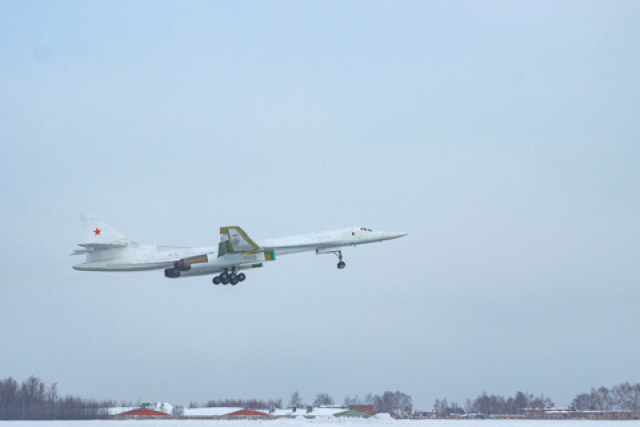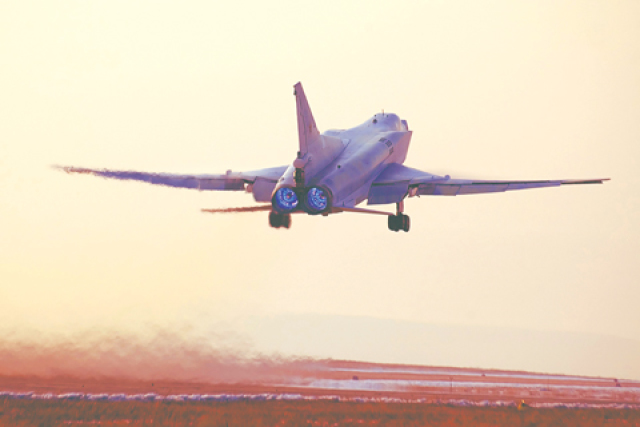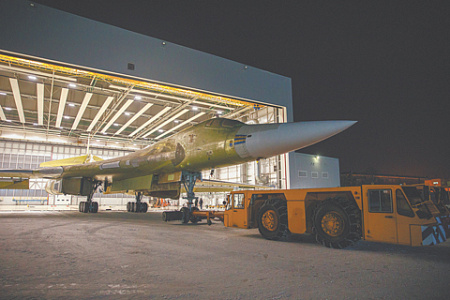A decisive increase in combat and quantitative composition is requiredAt the end of last year, the commander of the Long-range Aviation of the Russian Aerospace Forces, Lieutenant General Sergei Kobylash, spoke about the tasks of this kind of forces for 2023.
According to him, these tasks will be solved during the participation of Long-range aviation in a special military operation in Ukraine. This is the main feature of their implementation in the coming year.
According to the Ministry of Defense of the Russian Federation, the main tasks for Long-range aviation for 2023 remain the maintenance of a high level of combat readiness, combat training, serviceability of aircraft and weapons, as well as the development of new and modernized military equipment.
Currently, Long-range aviation in the structure of the Armed Forces of the Russian Federation and the Aerospace Forces of the Russian Federation is represented as a separate long-range aviation command. But it wasn't always like that. At different periods in the history of this kind of forces, the Long–range Aviation (in particular, in 1988) included three air armies of the Supreme Strategic Command - the 30th, 37th and 46th.
Currently, long-range aviation is a component of Russia's strategic nuclear forces. But unfortunately, the smallest.
Let's see how much the combat and numerical strength, organizational and staff structure of Long-range aviation, as well as the aviation weapons that are equipped with it, meet the requirements of the time.
COMBAT AND NUMERICAL STRENGTHCurrently, the combat composition of Long-range aviation is as follows.
22nd Heavy Bomber Division (22nd tbad, permanent base airfield – Engels, Saratov region) consisting of two regiments – the 121st Heavy Bomber Aviation Regiment (121st tbap, permanent base airfield - Engels) and the 184th Heavy Bomber Aviation Regiment (184th tbap, permanent base airfield based on Engels). Combat personnel of the 121st tbap - seven Tu–160M and nine Tu-160, combat personnel of the 184th tbap – 18 Tu-95MS vehicles.
52nd Heavy Bomber Aviation Regiment (52nd tbap, permanent base airfield – Shaikovka, Kaluga region). The combat personnel of the 52nd tbap – 23 Tu-22M3 vehicles.
326th Heavy Bomber Aviation Division (326th TBAD, permanent base airfield – Ukrainka, Amur region) consisting of two regiments – the 79th Heavy Bomber Aviation Regiment (79th tbap, permanent base airfield - Ukrainka) and the 182nd Heavy Bomber Aviation Regiment (182nd tbap, airfield permanent base – Ukrainian). The combat strength of the 79th tbap is 14 Tu-95MS vehicles. The combat strength of the 182nd tbap is 16 Tu-95MS vehicles.
200th Heavy Bomber Aviation Regiment (200th tbap, permanent base airfield – Belaya, Irkutsk region). The combat strength of the 200th tbap is 15 Tu-22M3 vehicles.
444th Heavy Bomber Aviation Regiment (444th tbap, permanent base airfield – Belaya, Irkutsk region). The combat strength of the 444th tbap is 14 Tu-22M3 vehicles.
203rd separate aviation regiment of tanker aircraft (203rd OAPSZ, permanent base airfield – Diaghilev, Ryazan region). The composition of the 203rd oapsz is 12 Il–78M vehicles and six IL-78 aircraft.
According to one open source, there are currently 17 Tu-160 aircraft, 60 Tu-95MS machines, and about 60 Tu-22M3 aircraft in the combat composition of Long-range aviation. At the same time, it should be noted that the data in open sources on the number of strategic and long-range bombers in long-range aviation are very contradictory. And how many of these aircraft are serviceable and fully ready for combat use is far from clear. For example, according to other open data, there are only 58 serviceable vehicles in combat today – 30 Tu-95MS units, 16 Tu-160 units, 12 Tu-22M3 units.

The plant in Kazan continues the modernization program of previously built bombers. Photo of PJSC "United Aircraft Corporation" Let's be honest and honest, it's not a lot.
The combat strength of many heavy bomber aviation regiments does not reach the established staffing strength – 18-20 vehicles. Naturally, in such a composition, Long-range aviation does not pull at an operational association in any way (the air army of the Supreme High Command of Strategic Purpose). And for these reasons, it cannot conduct air operations characteristic of Long-range aviation.
For example, the US Air Force currently has 20 Northrop B-2A Spirit strategic bombers, 61 Rockwell B-1B Lancer strategic bombers and 70 Boeing B-52 Stratofortress strategic bombers, a total of 151 aircraft. It is planned to replace them with about a hundred promising B-21 Raider strategic bombers.
PROMISING ORGANIZATIONAL AND STAFF STRUCTUREIn order to bring the Long-range Aviation Command to the operational level, to reform it into the air army of the Supreme High Command (VGK) of strategic purpose and to give it the opportunity to conduct long-range aviation air operations, the combat strength must be increased at least several times.
The most important thing is that it is advisable to do this only on the basis of upgraded machines such as Tu–95MSM, Tu-160M and Tu-22M3. And at the same time form at least one regiment equipped with PAK DA (a promising long-range aviation complex).
In this case, the Strategic Air Force will be able to fully solve the following tasks using only conventional means of destruction:
– hit enemy aircraft at airfields, destroy their fuel and ammunition depots;
– to carry out the destruction of military industry facilities, state and military management systems;
– defeat operational and strategic reserves, as well as enemy air defense means.
To do this, it is necessary to include at least the following units and formations in the composition of the air army of the Strategic Military Command:
– one heavy bomber aviation regiment on new generation strategic bombers (PAK DA);
– one heavy bomber aviation division equipped with Tu-160M strategic bombers (two regiments of 20 aircraft, 40 vehicles in total);
– two heavy bomber aviation divisions (two regiments each, more than 80 long-range Tu-22M3M bombers in total);
– 22nd heavy bombardment aviation division (bringing the combat strength of the regiments to at least 18 vehicles);
– 326th Heavy Bomber Aviation Division (bringing the combat strength of the regiments to 18 vehicles);
– three heavy bomber aviation regiments (52nd tbap, 200th tbap, 444th tbap) on Tu-22M3 aircraft (bringing the number of aircraft in each regiment to the established staff);
– The 203rd separate aviation regiment of tanker aircraft (in addition to it, form at least three more aviation regiments of tanker aircraft (each with 20 cars), and in total have at least 80 Il-78 vehicles).

According to the decision of the Ministry of Defense of the Russian Federation, a project is being implemented to extend the service life and expand the composition of the means of destruction of Tu-22M3 aircraft. Photo of PJSC "United Aircraft Corporation" That is, in the future, the combat strength of Long-range aviation should consist of at least 260 combat aircraft and at least 80 tanker aircraft.
In addition, Long-range aviation cannot be recognized as fully combat-ready if it does not include specialized electronic warfare aircraft. And you need to have about one such machine per squadron, that is, only about 20-25 aircraft.
If such figures seem obviously unrealistic to someone, then an alternative should be indicated: either we have Long-range aviation with proper operational and strategic capabilities, or we only designate its presence.
Of course, such a combat and numerical composition of Long–range aviation at best can be achieved – and this is with the most optimistic forecasts - no earlier than 2030. But at least such plans should be included in the relevant plans for the construction of the Armed Forces of the Russian Federation and in state armament programs.
AVIATION WEAPONS OF DESTRUCTIONThe range of aviation weapons for strategic and long-range bombers needs to be significantly increased.
First of all, this applies to large-caliber free-fall bombs (3-9 tons or more).
These include, for example, the three-ton FAB-3000M-54 and the five-ton FAB-5000M-54. The only carrier of the FAB-3000M-54 and FAB-5000M-54 is currently the Tu-22M3 long-range bomber.
An aviation vacuum bomb of increased power (AVBPM) is also being developed in Russia. According to available official data, the total mass of the AVBPM product exceeds 7.5–8 tons. The explosive mass of this munition is 7,100 kg, the TNT equivalent is 44 tons. However, as is known, AVBPM has not yet been received for equipping Long-range aviation.
Among other things, a significant part of the Long-range aviation fleet is intended only for the combat use of cruise missiles. At the same time, strategic bombers are not equipped for bombing with conventional free-fall bombs. There is reason to believe that this lack of long-range aviation should be resolutely eliminated, and this will significantly increase its combat capabilities in a war using only conventional means of destruction.
First of all, it is necessary to revise the means of destruction for Tu-22M3M bombers in the direction of increase – from guided and planning free-fall bombs (JDAM type) to long-range cruise missiles. One air-to-surface cruise missile of the X-32 type will not be enough for the Tu-22M3M.
As for the number of air-launched cruise missiles in the arsenals for Long-range aviation, it is necessary to reach such a quantitative level that this kind of VKS forces in its first air operation could achieve an operational and strategic result.
Long-range aviation has been and remains the most important component of the Aerospace Forces of the Armed Forces of the Russian Federation – both in relation to its tasks and in relation to its special capabilities. It seems that for its development it is necessary to make qualitatively different efforts than at present. We can only hope that the plans for the modernization of DA fully meet today's realities.
Mikhail KhodarenokMikhail Mikhailovich Khodarenok is a journalist.



